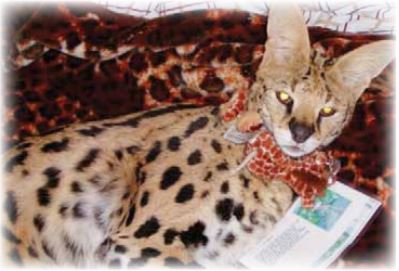 Our newest resident arrived one beautiful Sunday afternoon. During one of our Sunday tours, our Director, Nick, was approached by a couple who wanted a short tour of our facility. They had a pet, Serval, that was no longer working out in their home environment. After taking a quick time and asking questions of Nick and Julie, the couple asked if we would be willing to take in their pet. She was bought from a breeder in Texas, lived in their home for five years, and bonded with the father but not the rest of the family. They decided she needed to be in a facility like ours and would probably be much happier. Recently the two servals housed with Tabou had passed away, and Tabou was lonely, so it was a perfect fit! They were introduced later that day and are still getting to know each other. Being the sweet-natured cat that he is, Tabou is giving her space! Serenity Springs wants to send a BIG thanks to this family for adopting Vannah. The Serval, Leptailurus Serval, is a medium-sized African wild cat. Modern molecular DNA analysis indicates that servals maintain their unique lineage descending from the same Field ancestor as the lion. Though the Serval shares common traits with the cheetah, the cheetah is thought to have descended from ancient servals. Similar DNA studies have shown the African Golden Cat, and the Caracal is closely related to the Serval and may have branched by cross-breeding.
Our newest resident arrived one beautiful Sunday afternoon. During one of our Sunday tours, our Director, Nick, was approached by a couple who wanted a short tour of our facility. They had a pet, Serval, that was no longer working out in their home environment. After taking a quick time and asking questions of Nick and Julie, the couple asked if we would be willing to take in their pet. She was bought from a breeder in Texas, lived in their home for five years, and bonded with the father but not the rest of the family. They decided she needed to be in a facility like ours and would probably be much happier. Recently the two servals housed with Tabou had passed away, and Tabou was lonely, so it was a perfect fit! They were introduced later that day and are still getting to know each other. Being the sweet-natured cat that he is, Tabou is giving her space! Serenity Springs wants to send a BIG thanks to this family for adopting Vannah. The Serval, Leptailurus Serval, is a medium-sized African wild cat. Modern molecular DNA analysis indicates that servals maintain their unique lineage descending from the same Field ancestor as the lion. Though the Serval shares common traits with the cheetah, the cheetah is thought to have descended from ancient servals. Similar DNA studies have shown the African Golden Cat, and the Caracal is closely related to the Serval and may have branched by cross-breeding.
The cat’s length is 33-44 inches, plus 12-18 inches of tail, and the shoulder height is about 21-26 inches. Weight ranges from 20-35 lbs in females and 26-57 lbs in males. Life expectancy is about 12–16 years in the wild and 20–25 years in captivity. It is a strong yet slender animal with long legs and a short tail. The head is small concerning the body, and the tall, oval ears are set close together. The pattern of the fur is variable. Usually, the Serval is boldly spotted black on tawny, with 2 or 4 stripes from the top of the head down the neck and back, transitioning into spots. The “servaline” form has much more minor, freckled imperfections. In addition, melanism is known to exist in this species. White servals are white with silvery grey spots and have only occurred in captivity.
Its primary habitat is the savanna, although melanistic individuals are usually found in mountainous areas. The Serval needs watercourses within its territory so it does not live in semi-deserts or dry places. It can climb and swim but seldom does so. It has now dwindled in numbers due to the human population taking over its habitat and hunting its pelt. It is protected in most countries.
Domestication
Servals have historically been kept as pets in Africa. The Ancient Egyptians worshipped the Serval as Gods and kept them as pets. They have been marked as pets in North America and Europe. Servals develop an intense emotional bond with their original owners. Often, they will choose one member of the human family they live with to form an uncommonly close and low bond. However, once they have bonded with a particular human family, servals do not readily accept new owners or surroundings. They may become quite unhappy if separated or placed with other families. For this reason, anyone taking in a serval must be willing to house and keep the Serval for its entire life. In the United States, owning a serval requires unique licensing from local, State, and Federal agencies.
Recently, servals have been bred with the domestic cat to create a hybrid breed of domestic cat called the Savannah. These animals tend to be smaller than the Serval but retain the markings and color of the Serval. These animals are more tolerant of multiple owners, reliably litter trained, and tend to be more social with strangers. However, because breeding can be difficult, the first-generation (F1) animals tend to remain less common and expensive (as cat breeds go). Most states consider the product of a wild animal and a domestic cat to be a domestic cat. Therefore, regulations for owning these animals are similar to owning any domestic cat.